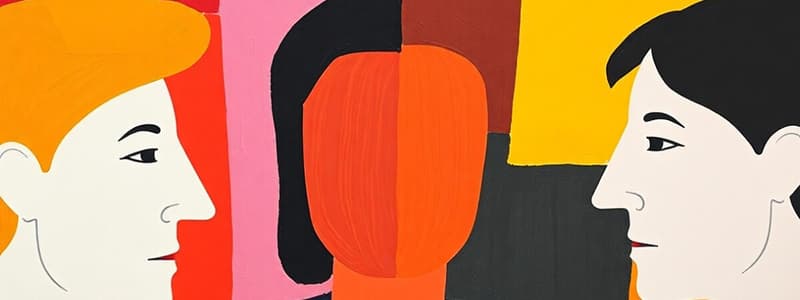Podcast
Questions and Answers
What defines cognitive prejudice?
What defines cognitive prejudice?
- Social categorization of individuals
- Acts of discrimination against a group
- Emotional reactions towards a group
- Generalizations about a group with specific characteristics (correct)
Which measure reflects physiological reactions in assessing prejudice?
Which measure reflects physiological reactions in assessing prejudice?
- Association Task Measure
- Donations to charity measure
- Skin conductance measures (correct)
- Self-report questionnaires
According to Social Identity Theory, where do individuals derive their self-esteem from?
According to Social Identity Theory, where do individuals derive their self-esteem from?
- Belonging to specific social groups (correct)
- The balance of individual life experiences
- Interactions with outgroups
- Personal achievements
Which of the following is NOT a common type of prejudice listed?
Which of the following is NOT a common type of prejudice listed?
What kind of conditioning can contribute to the development of prejudices?
What kind of conditioning can contribute to the development of prejudices?
The concept of social categorization involves placing individuals into what?
The concept of social categorization involves placing individuals into what?
What negative behavior exemplifies the affective component of prejudice?
What negative behavior exemplifies the affective component of prejudice?
In Jane Elliot's blue eyes vs. brown eyes experiment, what was the outcome for ingroup students?
In Jane Elliot's blue eyes vs. brown eyes experiment, what was the outcome for ingroup students?
What is the primary finding of the Minimal Group Paradigm?
What is the primary finding of the Minimal Group Paradigm?
In the experiments conducted by Tajfel et al. (1971), what percentage of participants favored their ingroup?
In the experiments conducted by Tajfel et al. (1971), what percentage of participants favored their ingroup?
What factor contributes most significantly to the development of hostility within ingroups?
What factor contributes most significantly to the development of hostility within ingroups?
What concept explains the justification of prejudiced behavior after experiencing cognitive dissonance?
What concept explains the justification of prejudiced behavior after experiencing cognitive dissonance?
How did Navarrete et al. (2012) demonstrate conditioned fear among participants related to their ingroup and outgroup?
How did Navarrete et al. (2012) demonstrate conditioned fear among participants related to their ingroup and outgroup?
What was a significant finding of the Berscheid et al. (1968) study regarding shock administration?
What was a significant finding of the Berscheid et al. (1968) study regarding shock administration?
What key aspect of human psychology does the Minimal Group Paradigm emphasize?
What key aspect of human psychology does the Minimal Group Paradigm emphasize?
Which of the following scenarios likely leads to quicker development of fear and hostility towards an outgroup?
Which of the following scenarios likely leads to quicker development of fear and hostility towards an outgroup?
What is an essential component for the well-being of both urban residents and rural-to-urban migrants in China?
What is an essential component for the well-being of both urban residents and rural-to-urban migrants in China?
According to Intergroup Contact Theory, what is the primary effect of interactions between individuals from different groups?
According to Intergroup Contact Theory, what is the primary effect of interactions between individuals from different groups?
Which type of interaction is NOT necessary for reducing prejudice according to the content?
Which type of interaction is NOT necessary for reducing prejudice according to the content?
What effect can positive stories about outgroups have, based on Ramasubramanian's 2015 research?
What effect can positive stories about outgroups have, based on Ramasubramanian's 2015 research?
What is a common outcome when individuals experience contact with members of an outgroup?
What is a common outcome when individuals experience contact with members of an outgroup?
What does Maunder et al. (2019) suggest about contact with outgroup members?
What does Maunder et al. (2019) suggest about contact with outgroup members?
Experience from which of the following scenarios could potentially increase prejudice?
Experience from which of the following scenarios could potentially increase prejudice?
Which statement best describes the objective of counter-stereotypical conditions in media, as illustrated by Ramasubramanian's research?
Which statement best describes the objective of counter-stereotypical conditions in media, as illustrated by Ramasubramanian's research?
What effect occurs when information about one member influences perceptions of the entire group?
What effect occurs when information about one member influences perceptions of the entire group?
What is the Outgroup Homogeneity Effect characterized by?
What is the Outgroup Homogeneity Effect characterized by?
Which study examined the accuracy of predicting decisions based on group membership?
Which study examined the accuracy of predicting decisions based on group membership?
What consequence occurs when an outgroup member is portrayed negatively?
What consequence occurs when an outgroup member is portrayed negatively?
What does the Common Ingroup Identity Model suggest for reducing prejudice?
What does the Common Ingroup Identity Model suggest for reducing prejudice?
Which model includes the concept of maintaining subgroup identities while fostering a shared group identity?
Which model includes the concept of maintaining subgroup identities while fostering a shared group identity?
What is a potential challenge of the Common Ingroup Identity Model?
What is a potential challenge of the Common Ingroup Identity Model?
Which of the following is a common behavioral intention resulting from negative stereotypes about an outgroup?
Which of the following is a common behavioral intention resulting from negative stereotypes about an outgroup?
Flashcards
Prejudice
Prejudice
A negative attitude towards a group of people based on their membership in that group.
Implicit Bias
Implicit Bias
An unconscious, automatic negative attitude or belief about a group of people.
Stereotypes
Stereotypes
Generalizations about a group that assign specific characteristics to all its members.
Affective Bias
Affective Bias
Signup and view all the flashcards
Discrimination
Discrimination
Signup and view all the flashcards
Ingroup
Ingroup
Signup and view all the flashcards
Outgroup
Outgroup
Signup and view all the flashcards
Social Identity Theory
Social Identity Theory
Signup and view all the flashcards
Individual to Group Generalisation
Individual to Group Generalisation
Signup and view all the flashcards
Generalisation Effect
Generalisation Effect
Signup and view all the flashcards
Outgroup Homogeneity Effect
Outgroup Homogeneity Effect
Signup and view all the flashcards
Common Ingroup Identity Model
Common Ingroup Identity Model
Signup and view all the flashcards
Dual Identity Model
Dual Identity Model
Signup and view all the flashcards
Superordinate Identity
Superordinate Identity
Signup and view all the flashcards
Subgroup Identity
Subgroup Identity
Signup and view all the flashcards
Minimal Group Paradigm
Minimal Group Paradigm
Signup and view all the flashcards
Ingroup Favouritism
Ingroup Favouritism
Signup and view all the flashcards
Outgroup Negativity
Outgroup Negativity
Signup and view all the flashcards
What was the key finding of Tajfel et al.'s (1971) study?
What was the key finding of Tajfel et al.'s (1971) study?
Signup and view all the flashcards
Conditioned Fear in Ingroups and Outgroups
Conditioned Fear in Ingroups and Outgroups
Signup and view all the flashcards
Cognitive Dissonance
Cognitive Dissonance
Signup and view all the flashcards
How does cognitive dissonance relate to prejudice?
How does cognitive dissonance relate to prejudice?
Signup and view all the flashcards
Berscheid et al.'s (1968) study on electric shocks
Berscheid et al.'s (1968) study on electric shocks
Signup and view all the flashcards
Counter-stereotypical Conditions
Counter-stereotypical Conditions
Signup and view all the flashcards
Intergroup Contact Theory
Intergroup Contact Theory
Signup and view all the flashcards
Vicarious Contact
Vicarious Contact
Signup and view all the flashcards
Imagined Contact
Imagined Contact
Signup and view all the flashcards
Virtual Reality (VR) Contact
Virtual Reality (VR) Contact
Signup and view all the flashcards
Socially Normative Contact
Socially Normative Contact
Signup and view all the flashcards
Short-term Contact
Short-term Contact
Signup and view all the flashcards
Study Notes
Prejudice Definition
- Prejudice is an attitude
- It's a hostile, negative attitude towards a distinct group of people
- Group membership is the sole basis for prejudice
- Prejudice is directed at individuals because of their group affiliation
Prejudice Measures
- Association Task Measure: measures implicit bias
- Skin conductance measures: physiological measure
- Donations to charity measure: behavioural measure
- Self-report questionnaires: measure explicit bias
Components of Prejudice
- Cognitive: Stereotypes are generalizations about a group, assigning specific characteristics. These are the beliefs and schemas about how we think of the group. An example is believing someone is lazy.
- Affective: Emotional/affect reactions towards the group. Examples include hate and feelings of contempt towards an individual or a group.
- Behavioural: Acts of discrimination, which are unjustified and negative or harmful behaviours towards a group member, based on their group membership. Examples include refusing to hire someone because of their ethnicity.
Attitude Object
- Individual members of a group
Common Types of Prejudices
- Homophobia
- Transphobia
- Sexism
- Racism
- Antisemitism (Jewish religion)
Prejudices Come From
- Operant conditioning
- Social learning
- War
- Direct experience
- Interpersonal conflict
- Classical conditioning
- Genes
Social Categorisation
- Process where people categorise; themselves and others into distinct social groups
- Two types: ingroups and outgroups
- Common social categorisations include:
- Race
- Religion
- Social class/status
- Gender
- Sexuality
- Marital status
Social Identity Theory
- Individuals derive part of their self-esteem from the groups they belong to
- A person's sense of self is based on their group memberships
- People need their groups to see themselves positively
Categorisation that Causes Prejudices
- School Teacher Jane Elliot's experiment (blue eyes vs. brown eyes) in which students' behaviour, personalities and academic performance improved after categorizing
- Students' positive behaviour was noticed when blue eyed students were deemed superior
Minimal Groups Paradigm
- Not a theory, just a model
- Discovered that minimal conditions are needed for prejudices to occur between groups
- Shows one tiny factor is all that is needed for people to feel part of an ingroup and their self-esteem associated with being in a group grows
- Also noted the negativity that occurs when members are placed in outgroups
Minimal Group Experiment
- Navarrete et al. (2012) – Psychology students, different coloured shirts to create in- and out-groups tested their fear of in-group and out-group association with electric shocks
- It was found that people demonstrated more fear and dislike of out-groups faster and stronger than of in-groups
Realistic Conflict Theory
- Conflict between groups over goals and resources produces prejudice
- Sherif & Sherif (1954) Robbers Cave Summer Camp study
- In groups, hostility arises from competing goals; when limited resources or prizes are at stake, hostilities occur
- People associate positive attributes with their ingroups
Cognitive Dissonance
- Justifying prejudiced behaviour; this occurs when we face cognitive dissonance due to acting prejudiced
- We devise reasons to justify our actions to feel consistent
- Berscheid et al. (1968) electric shock study – Participants justify their actions to feel consistent
Individual to Group Generalisation
- The observed characteristic of a single group member informs the perceptions of the entire group
Generalisation Effect
- Dangerous
- All dangerous
Outgroup Homogeneity Effect
- We perceive individuals in an outgroup as being more similar than they are; outgroup members seen as "all alike"
- Conversely, members of our ingroup are seen as individuals
- Research by Quattrone & Jones (1980)
Research Outgroup Homogeneity Effect
- PUHL ET AL. (2013): Generalization about Obese People
Common Ingroup Identity Model
- A larger identity overriding smaller groups will reduce prejudice
- Ingroup bias can be reduced if people in different groups view themselves as a part of a larger group
- Limitations: Dovidio et al., (2009) noted that superordinate identities are difficult to maintain and may encounter resistance
The Dual Identity Model
- A larger identity encompassing both groups, while sustaining the smaller ones, reduces prejudice and sustains individual subgroup identities.
- Simultaneous activation of subgroup and a shared group identity
- Extends ingroup favouritism to outgroup members
- Allows outgroup members to maintain their subgroup identities
Reducing Prejudice- Generalisation with Counter Stereotypical Conditions
- Ramasubramanian (2015): Stories about Morgan Freeman and Beyoncé Knowles illustrating counter-stereotypical conditions
- Stories about positive outgroup members (African Americans) changed negative stereotypes
Intergroup Contact Theory
- Interactions between individuals from different groups reduce prejudice toward the groups they represent
- We learn from interactions with outgroup members that they don't always fit stereotypes: leading to a positive outlook
Reducing Prejudice Generalisations with Intergroup Contact Theory
- Interaction between individuals of different groups alleviates prejudice between those groups
- Contact with outgroup members challenges stereotypes and improves attitudes towards the entire group
Contact Doesn't Need to Be Face-to-Face
- Interaction isn't limited to face to face, it can also be vicarious – observing one group member interacting positively with another
Reducing Prejudice Generalisation Teacher – Rachel Own Study
- Maunder et al., 2019 study
- Contact and interactions with outgroup members reduce prejudice
- Contact in all forms, including online chat rooms, VR, or face to face interaction leads to less prejudice
Criticism of Intergroup Contact
- Experiments may not fully reflect reality
- Real-world intergroup contact isn't always socially normative
- Short term : negative interactions still occur which worsens prejudice
- Stripped of intergroup tension: situations don't always automatically lead to association
Intergroup Contact Criticisms
- McKeown & Dixon (2017) - Intergroup contact can have a "sedative effect", reducing recognition of inequality; less allyship amongst minority groups
- Contact can lead to feelings of similarity with the majority, expectations of fair treatment, decreased bias from attribution of discrimination, and legitimization of power structures.
Studying That Suits You
Use AI to generate personalized quizzes and flashcards to suit your learning preferences.
Related Documents
Description
This quiz explores the definition of prejudice, its components, and various measures to assess it. From cognitive aspects to behavioral reactions, you'll learn how prejudice manifests and is evaluated through different methods. Test your understanding of these crucial social concepts.




